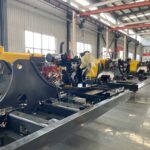Introduction
In the world of material handling and construction, efficiency and versatility are key factors that drive productivity and success. One remarkable piece of machinery that has been gaining popularity for its exceptional performance is the telescopic wheel loader. Combining the functionalities of a traditional wheel loader and a telehandler, this innovative equipment offers a wide range of benefits that cater to various industries. In this article, we will delve into the features, applications, advantages, and future prospects of telescopic wheel loaders, exploring how they have transformed the landscape of material handling.
Table of Contents
- Understanding Telescopic Wheel Loaders
- What are Telescopic Wheel Loaders?
- How do Telescopic Wheel Loaders Work?
- Components of a Telescopic Wheel Loader
- Versatility in Applications
- Construction Sites
- Agriculture and Forestry
- Warehousing and Distribution
- Municipal Services
- Advantages of Telescopic Wheel Loaders
- Increased Reach and Lift Height
- Improved Maneuverability
- Time and Cost Efficiency
- Enhanced Operator Comfort and Safety
- Selecting the Right Telescopic Wheel Loader
- Weight Capacity and Lift Height
- Attachments and Versatility
- Fuel Type and Emission Standards
- Maintenance and After-Sales Support
- Telescopic Wheel Loaders: Present and Future
- Current Market Trends
- Technological Advancements
- Environmental Considerations
- Growth Prospects
Understanding Telescopic Wheel Loaders

What are Telescopic Wheel Loaders?
Telescopic wheel loaders, also known as tele-wheel loaders or telescopic handlers, are advanced and versatile machines used in various industries for material handling tasks. Combining the functionalities of traditional wheel loaders and telehandlers, these innovative machines are equipped with a telescopic boom that can extend and retract vertically, providing exceptional reach and lift height capabilities.
The primary purpose of telescopic wheel loaders is to efficiently lift, move, and load heavy materials, making them indispensable in construction, agriculture, forestry, warehousing, and municipal services. Their unique design allows them to handle a wide range of materials, from construction components and agricultural produce to logs and pallets.
How do Telescopic Wheel Loaders Work?
Telescopic wheel loaders operate using hydraulic systems that power the telescopic boom and the lifting arm. By adjusting the hydraulic pressure, operators can control the extension and retraction of the boom, allowing for precise positioning of loads at varying heights. The four-wheel-drive system ensures excellent maneuverability even in challenging terrains.
Components of a Telescopic Wheel Loader
A typical telescopic wheel loader consists of several key components. These include the telescopic boom, lifting arm, hydraulic cylinders, counterweight, cab, and the engine compartment. The combination of these elements enables the machine to perform a wide range of material handling tasks efficiently.
Versatility in Applications
Construction Sites
Telescopic wheel loaders have become indispensable in construction sites. Their ability to reach significant heights makes them ideal for loading materials onto scaffolding, handling heavy construction components, and lifting pallets of construction materials to elevated work areas.
Agriculture and Forestry
In the agricultural sector, telescopic wheel loaders are used for loading and unloading crops, transporting materials around the farm, and assisting with tasks like stacking hay bales. In forestry applications, these loaders play a crucial role in moving logs and loading them onto trucks for transportation.
Warehousing and Distribution
Telescopic wheel loaders find applications in warehouses and distribution centers where they are utilized to load and unload goods from trucks, stack pallets, and move materials efficiently within confined spaces.
Municipal Services
Municipalities employ telescopic wheel loaders for various services such as clearing debris, snow removal, and street maintenance. The machines’ versatility allows them to handle different tasks efficiently, reducing the need for multiple types of equipment.
Advantages of Telescopic Wheel Loaders
Increased Reach and Lift Height
One of the primary advantages of telescopic wheel loaders is their ability to reach higher elevations compared to conventional wheel loaders. This feature enhances productivity, especially in construction projects where materials need to be lifted to significant heights.
Improved Maneuverability
Telescopic wheel loaders are designed with excellent maneuverability, making them suitable for tight spaces and challenging terrains. Their compact design allows them to navigate construction sites or warehouses with ease, reducing the chances of accidents and damage.
Time and Cost Efficiency
By combining the functionalities of multiple machines into one, telescopic wheel loaders contribute to time and cost savings. Construction sites, farms, and other industries benefit from reduced equipment requirements and increased efficiency in material handling tasks.
Enhanced Operator Comfort and Safety
Modern telescopic wheel loaders come equipped with comfortable cabs that provide excellent visibility and ergonomic controls. This enhances the operator’s comfort and reduces fatigue during long working hours. Moreover, safety features such as stability control systems ensure safe operations on uneven ground.
Selecting the Right Telescopic Wheel Loader
Weight Capacity and Lift Height
Weight capacity and lift height are two crucial factors to consider when selecting a telescopic wheel loader for specific material handling tasks. These aspects determine the machine’s ability to handle different loads effectively and reach the required heights for various applications.
Weight Capacity
The weight capacity of a telescopic wheel loader refers to the maximum weight it can safely lift and handle. It is essential to choose a machine with a weight capacity that matches the heaviest loads you anticipate handling regularly. Selecting a loader with insufficient capacity can lead to overloading, compromising the machine’s safety and performance.
Telescopic wheel loaders come in various weight capacity options to cater to different industries and applications. Light-duty loaders may have a lower weight capacity suitable for smaller loads and indoor use, while heavy-duty models offer higher capacities for more demanding tasks like construction and forestry.
Before making a choice, carefully assess the typical weight of the materials you will handle and consider potential future requirements. Opting for a loader with a slightly higher weight capacity than your immediate needs can provide flexibility and room for growth.
Lift Height
The lift height of a telescopic wheel loader refers to the maximum vertical distance it can extend its boom and lift materials. This feature is particularly crucial in scenarios where materials need to be placed at elevated work areas, such as construction sites or high-level storage in warehouses.
Consider the specific applications in which you will use the loader and the required lift height for those tasks. If you work on multi-story construction projects or need to load materials onto elevated platforms, a telescopic wheel loader with a higher lift height will be advantageous.
However, it is essential to strike a balance between lift height and overall machine stability. A significantly extended boom may reduce the loader’s stability and lifting capacity, especially when handling heavier loads at greater heights.
Attachments and Versatility
Telescopic wheel loaders support various attachments, such as forks, buckets, and lifting hooks. Choosing a machine with versatile attachment options enhances its usefulness and adaptability for different tasks.
Fuel Type and Emission Standards
Deciding on the fuel type is essential, as it impacts the loader’s efficiency and environmental footprint. Additionally, considering the loader’s compliance with emission standards helps reduce its impact on the environment.
Maintenance and After-Sales Support
Investing in a telescopic wheel loader requires considering the availability of spare parts and after-sales support. Opting for reputable brands with reliable service networks ensures smooth operations and minimizes downtime.
Telescopic Wheel Loaders: Present and Future

Current Market Trends
The market for telescopic wheel loaders is experiencing steady growth, driven by the demand for efficient material handling solutions across various industries. Manufacturers are continuously innovating to improve loader performance, safety, and sustainability.
Technological Advancements
Advancements in technology have led to the integration of telematics and IoT capabilities in telescopic wheel loaders. These features allow remote monitoring of the machine’s performance, predictive maintenance, and data-driven insights to optimize operations.
Environmental Considerations
In response to environmental concerns, manufacturers are focusing on producing telescopic wheel loaders that meet stringent emission regulations and prioritize fuel efficiency. Electric and hybrid models are also emerging as eco-friendly alternatives.
Growth Prospects
The future of telescopic wheel loaders appears promising, as they continue to gain popularity across diverse industries worldwide. The rise of automation and artificial intelligence is expected to further enhance the machines’ capabilities and efficiency.
Conclusion
Telescopic wheel loaders have emerged as game-changers in the material handling and construction industries. Their unique combination of reach, lift height, and maneuverability has revolutionized how tasks are accomplished on construction sites, farms, warehouses, and municipal services. As technology continues to advance, these versatile machines are expected to play an even more significant role in enhancing productivity and sustainability.
FAQs
- Are telescopic wheel loaders suitable for indoor applications?
Yes, telescopic wheel loaders are designed to handle both indoor and outdoor applications. Their compact size and excellent maneuverability make them well-suited for confined spaces and tight quarters within warehouses and distribution centers. - Can telescopic wheel loaders replace traditional forklifts?
While telescopic wheel loaders offer similar functionalities to forklifts, they are not direct replacements. Forklifts excel at vertical lifting, while telescopic wheel loaders provide extended reach capabilities, making them more versatile for specific tasks. - Do telescopic wheel loaders come with operator training?
Reputable manufacturers often provide operator training as part of their after-sales support. Proper training ensures safe and efficient handling of the equipment, reducing the risk of accidents and equipment damage. - What is the typical lifespan of a telescopic wheel loader?
The lifespan of a telescopic wheel loader depends on various factors, including usage, maintenance, and operating conditions. With proper care and maintenance, these machines can serve for thousands of working hours. - Are telescopic wheel loaders fuel-efficient?
Many modern telescopic wheel loaders are designed to be fuel-efficient, reducing operating costs and environmental impact. Additionally, the emergence of electric and hybrid models offers even greater fuel efficiency options.







-150x150.webp)
